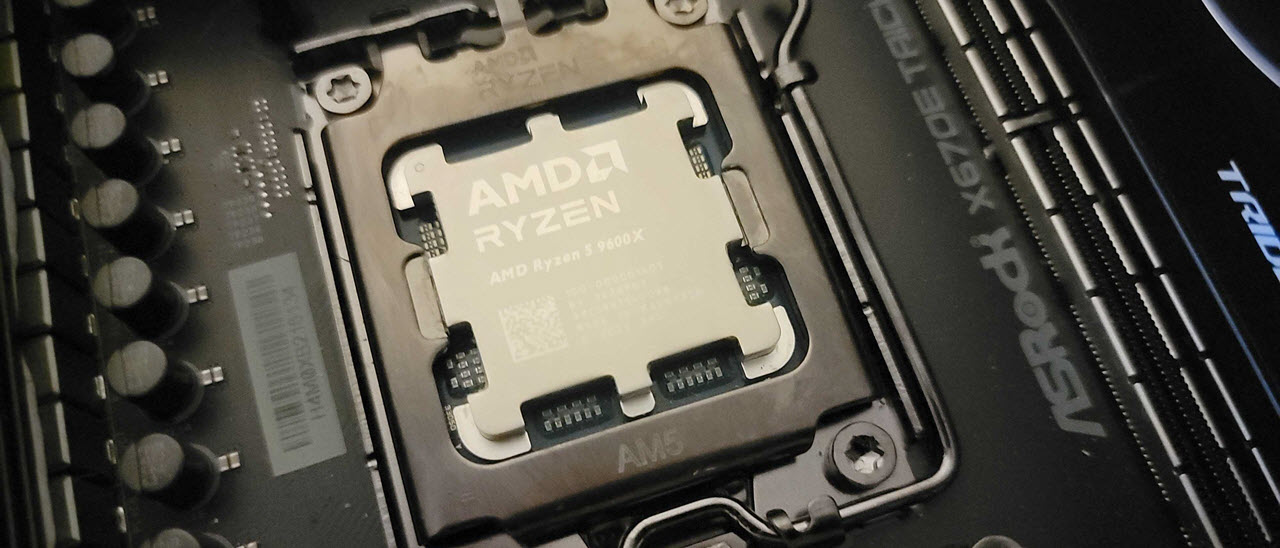Why you can trust Tom's Hardware
AMD Ryzen 5 9600X Power Consumption and Efficiency
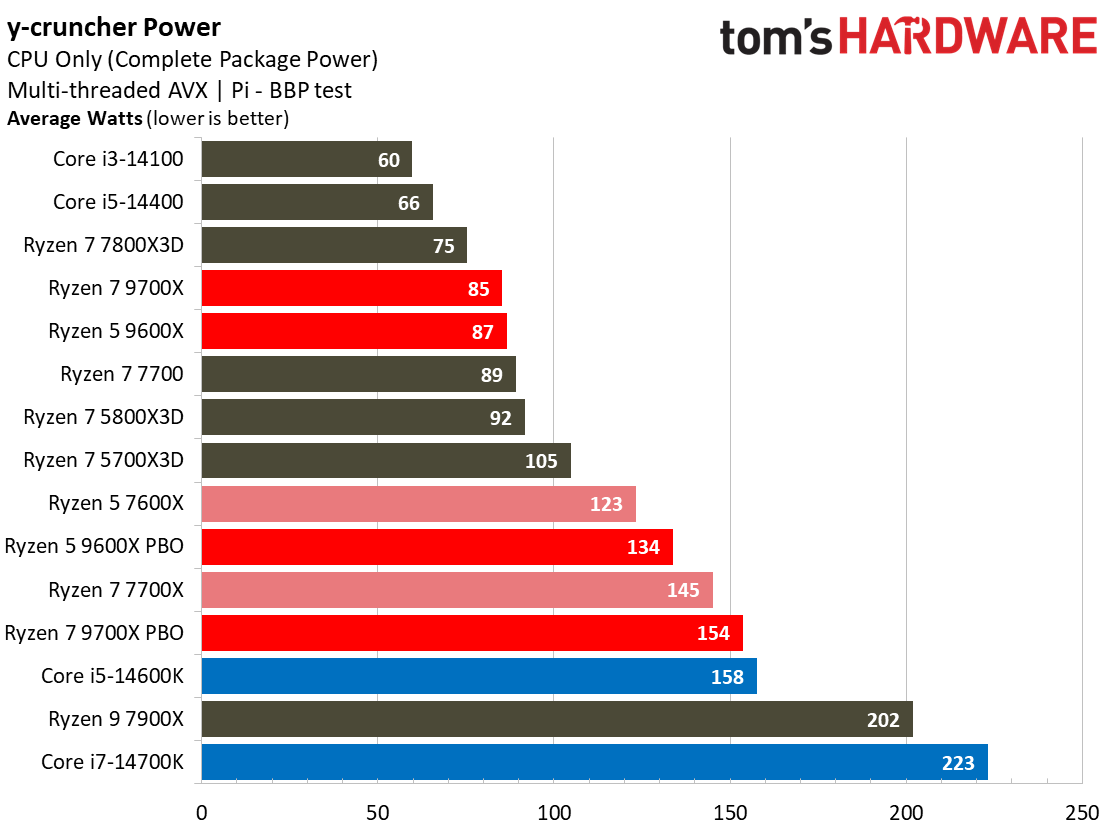
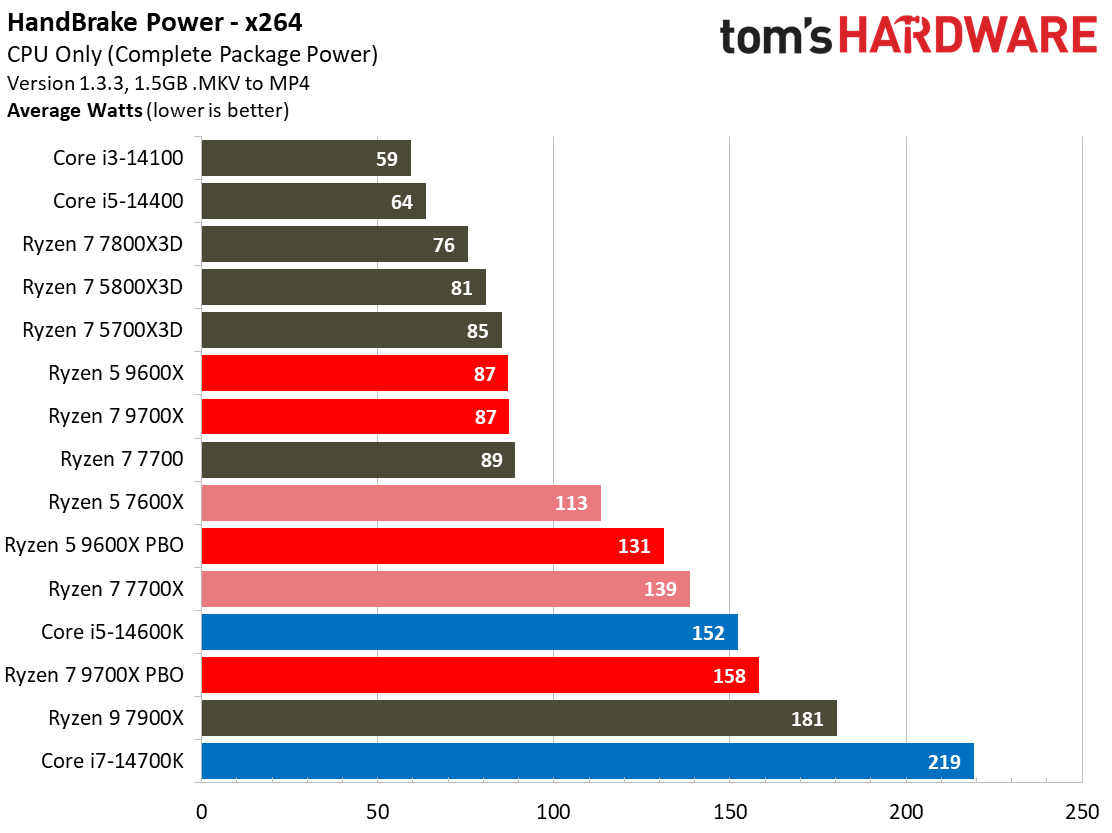

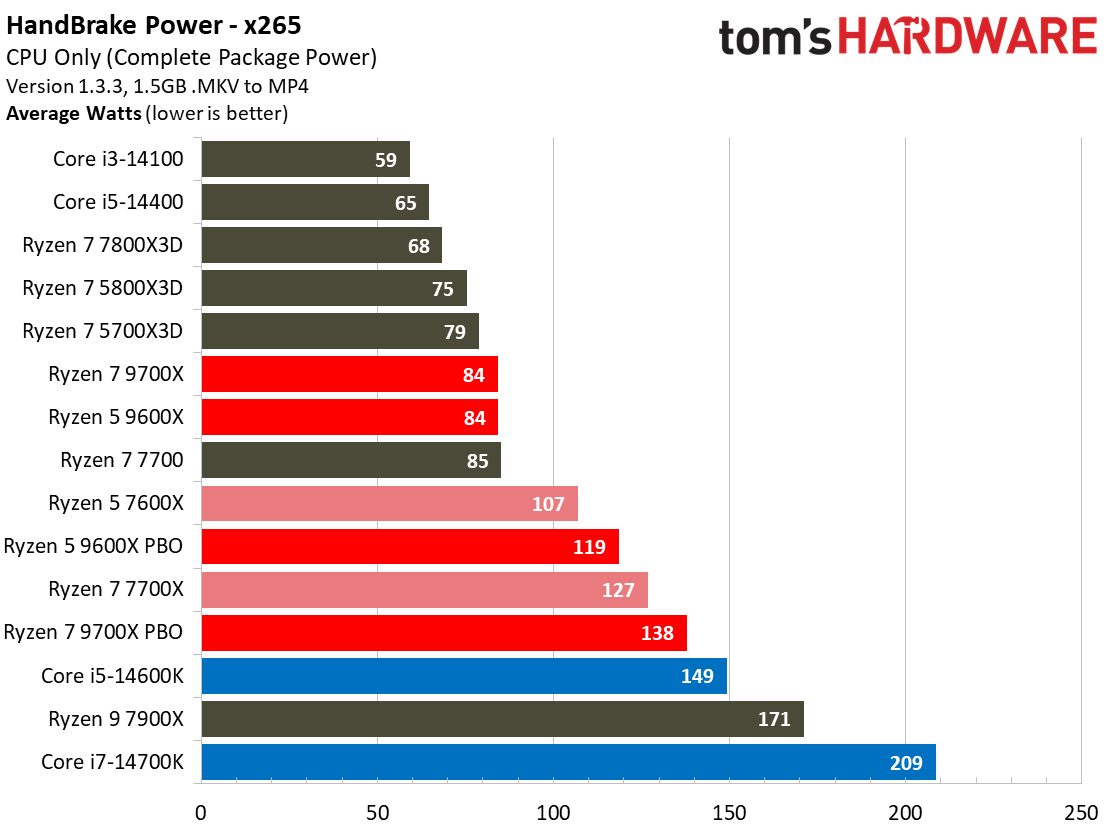
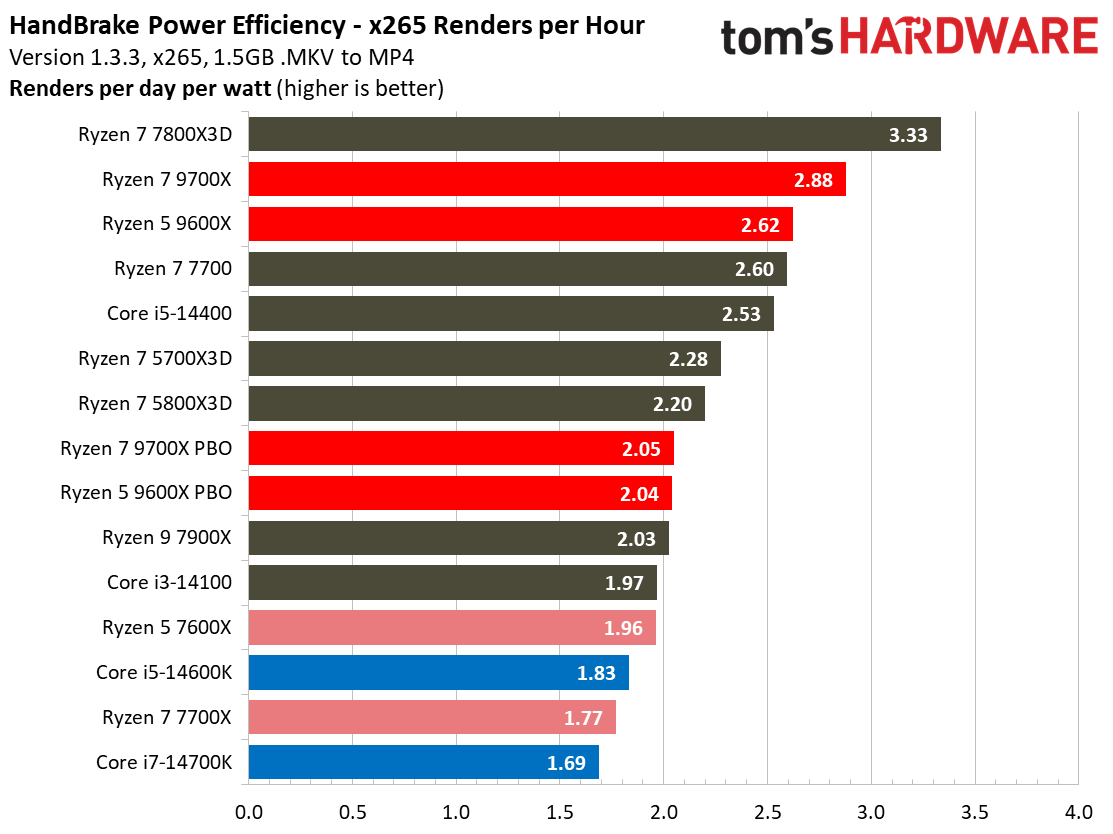


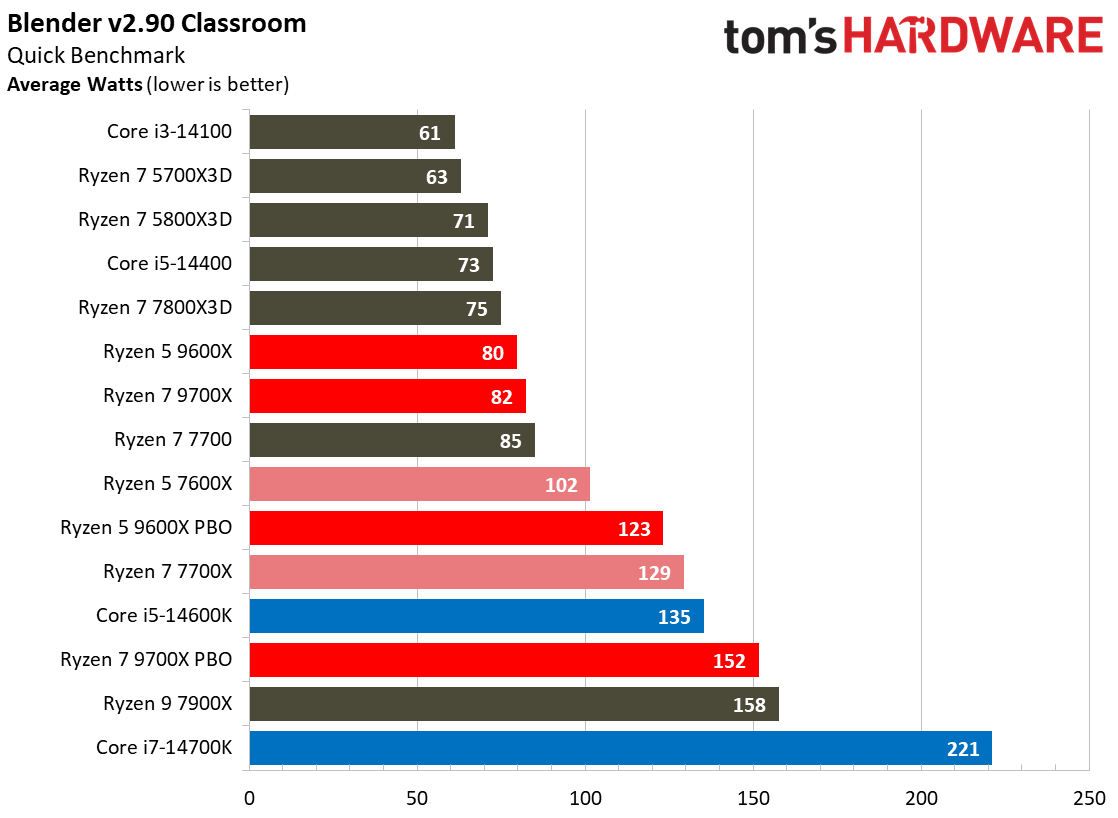
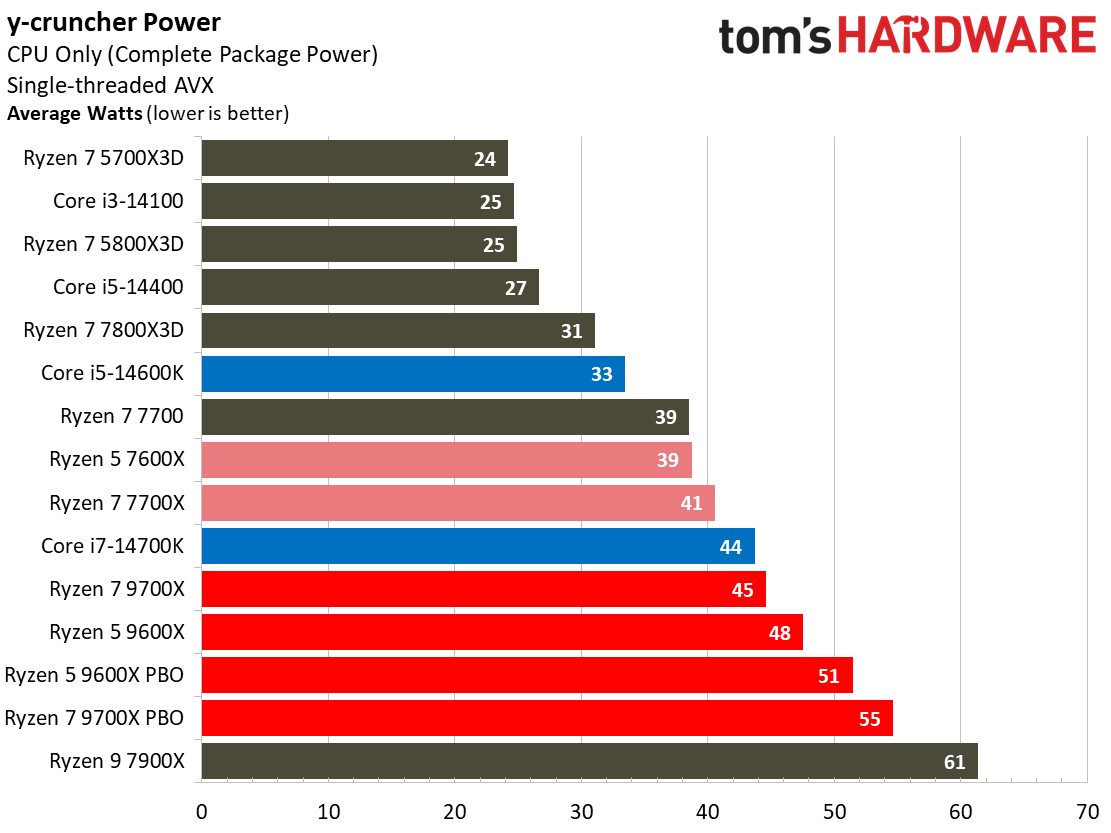
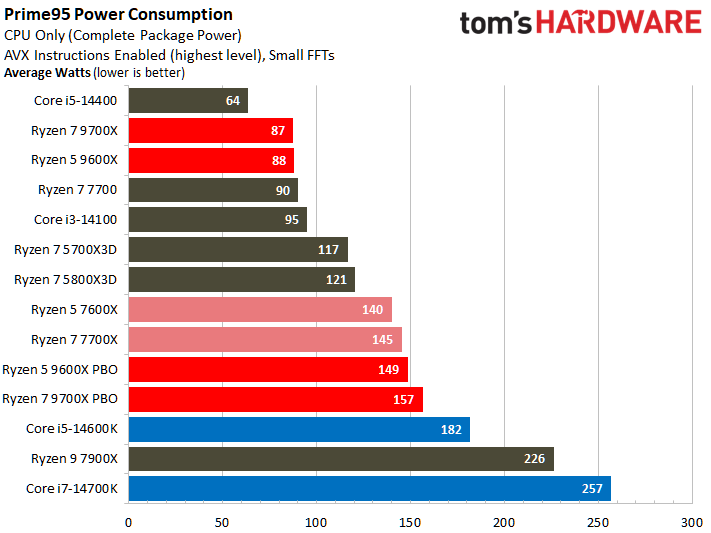
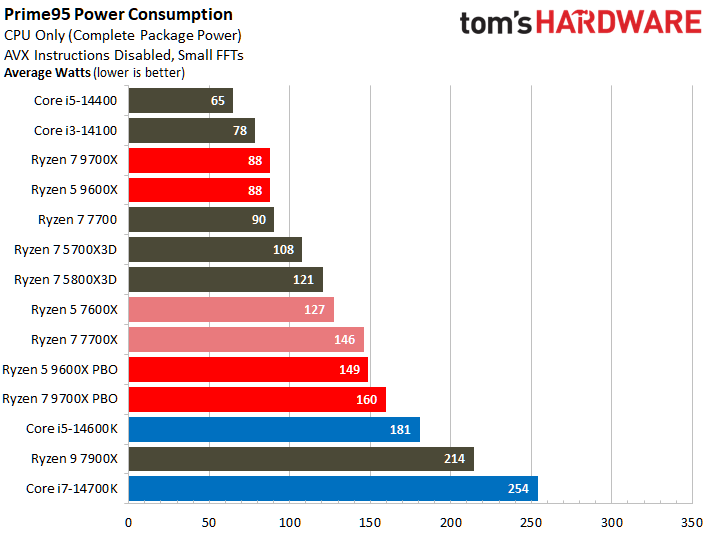
AMD's power reductions for the Zen 5 processors are simply outstanding. For instance, the Ryzen 5 9600X and Ryzen 7 9700X deliver excellent performance in the Pi-BBP AVX-512 benchmark yet sip power compared to the Intel processors.
In the Prime95 stress test with AVX instructions enabled, we recorded 257W from the stock Core i7-14700K and 182W from the Core i5-14600K, but the Ryzen models both topped out at a mere 88W at stock settings and only ~150W with PBO enabled. Thus, even when overclocked, AMD's new processors use quite a bit less power than Intel's stock-clocked 14th Gen counterparts.
Zen 5's incredible power consumption characteristics are reflected across the board in our measurements, and our HandBrake power efficiency metrics underline the advantages of the more efficient TSMC process node coupled with the Zen 5 microarchitecture.


The final image takes a slightly different look at power consumption by calculating the cumulative energy required to execute an x264 and x265 HandBrake workload. We plot this 'task energy' value in Kilojoules on the left side of the chart, with time taken on the x-axis.
These workloads consist of a fixed amount of work, so we can plot the task energy against the time required to finish the job (bottom axis), thus generating a really useful power chart. Faster compute times and lower task energy requirements are ideal. That means processors that fall the closest to the bottom left corner of the chart are the best.
These charts speak volumes to Zen 5's power efficiency — the Ryzen 9000 processors consume far less power per unit of work than the Intel comparables. The 9600X and 9700X both land in the bottom-left area, and while Intel's 14600K and 14700K take less time, they use significantly more power to get there. This is reflected by their top-left positioning.
Zen 5 Ryzen 9000 Thermals
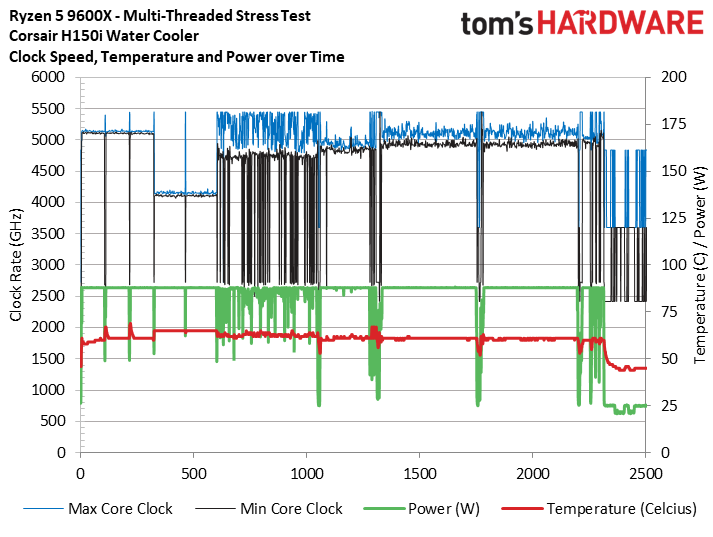
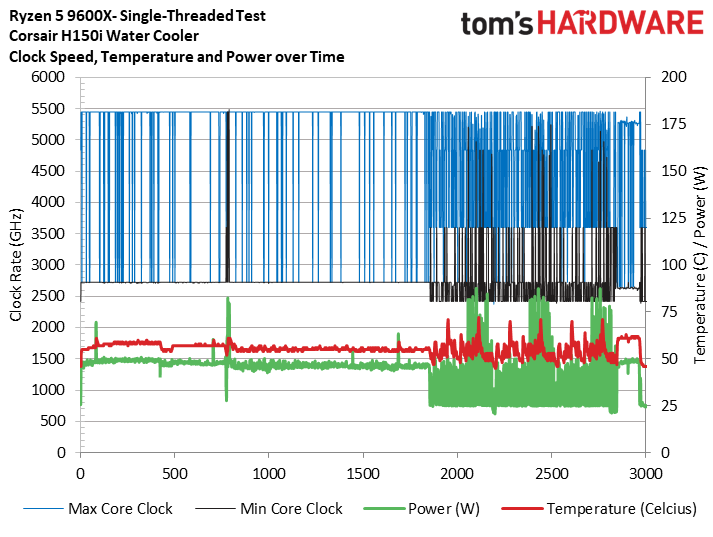
Naturally, lower power consumption equates to lower heat generation, and often more sustained boost residency. As you can see in the images above, we ran through a spate of standard heavily threaded applications (Corona, AVX-heavy y-cruncher, HandBrake, POV-Ray, Cinebench, and Blender) to measure power and thermals in multi-threaded work, and then another series of lightly-threaded apps to check performance in lighter fare (POV-Ray sT, LAME, Cinebench sT, Geekbench 6, y-cruncher sT).
The Ryzen 5 9600X never exceeded 69C during the multi-threaded test and peaked at 88W of power consumption. The chip also easily reached its rated boost of 5.4 GHz during the lightly threaded tests.
AMD Ryzen 5 9600X Overclocking, and Test Setup
- Ryzen 5 9600X: Default power limits, DDR5-5600
- Ryzen 5 9600X PBO: Precision Boost Overdrive (PBO) — advanced motherboard, 10X scalar, +200 MHz CPU clock, -20 Curve Optimizer, DDR5-6000 EXPO profile (fabric 2000 MHz, mclk/uclk 1:1)
- Ryzen 7 9700X: Default power limits, DDR5-5600
- Ryzen 7 9700X PBO: Precision Boost Overdrive (PBO) — advanced motherboard, 10X scalar, +200 MHz CPU clock, -20 Curve Optimizer, DDR5-6000 EXPO profile (fabric 2000 MHz, mclk/uclk 1:1)
We tested the Ryzen 5 9600X and Ryzen 7 9700X in standard stock trim and with overclocked memory coupled with the auto-overclocking Precision Boost Overdrive (PBO) feature. We used the DDR5-6000 EXPO profile for the Ryzen 5 7600X PBO configuration. We also used Precision Boost Overdrive (PBO) with the advanced 'motherboard' power presets. We then enabled a 10X scalar, a 200 MHz extra boost for the CPU, and a -20 undervolt using the Curve Optimizer for the CPU cores.
As noted in the introduction, Intel’s instability issue can potentially impact all its 65W and higher CPUs, and an unknown percentage of the processors experience the issues. Intel plans to deliver a microcode patch to address the issue within a few weeks. It has also extended its warranty for the impacted product lines by two additional years. For now, the company recommends using conservative power settings to help reduce the odds of errors occurring. Those recommendations are reflected in our testing, effectively giving the Intel chips a haircut in our performance benchmarks. Intel has also advised motherboard vendors to alter several settings on an ongoing basis, like eTVB, CEP, and ICCMAX, so it's unclear how much performance will be gained when the stringent new power limits are removed. [EDIT: We have now added testing with the new microcode fix.]
Microsoft has advised gamers to turn off several security features to boost gaming performance. For maximum performance, we disabled secure boot, virtualization support, and fTPM/PTT on all systems. The table below provides further hardware details.
Intel Socket 1700 DDR5 (Z790) | Intel Core i5-14400, Core i5-14600K, Core i3-14100, Core i7-14700K |
Motherboard | MSI Z790 Carbon Wifi |
RAM | G.Skill Trident Z5 RGB DDR5-6800 - Stock: DDR5-4800 (non-K) DDR5-5600 (K) |
AMD Socket AM5 (X670E) | Ryzen 5 9600X, Ryzen 7 9700X, Ryzen 7 7800X3D, Ryzen 9 7900X, Ryzen 7 7700X,Ryzen 5 7600X, Ryzen 7 7700 |
Motherboard | ASRock X670E Taichi |
RAM | G.Skill Trident Z5 Neo DDR5-6000 - Stock: DDR5-5600 (Ryzen 9000) — DDR5-5200 (Ryzen 7000) — OC: DDR5-6000 EXPO |
AMD Socket AM4 (X570) | Ryzen 7 5800X3D, 5700X3D |
Motherboard | MSI MEG X570 Godlike |
RAM | 2x 8GB Trident Z Royal DDR4-3600 - Stock: DDR4-3200 | OC/PBO: DDR4-3600 |
All Systems | 2TB Sabrent Rocket 4 Plus, Silverstone ST1100-TI, Open Benchtable, Arctic MX-4 TIM, Windows 11 Pro |
Gaming GPU | Asus RTX 4090 ROG Strix OC |
Application GPU | Nvidia GeForce RTX 2080 Ti FE |
Cooling | Corsair iCue Link H150i RGB |
Note: | Microsoft advises gamers to disable several security features to boost gaming performance. As such, we disabled secure boot, virtualization support, and fTPM/PTT. |
- MORE: Best CPU for gaming
- MORE: CPU Benchmark Hierarchy
- MORE: Intel vs AMD
- MORE: How to Overclock a CPU
Current page: AMD Ryzen 5 9600X Power Consumption, Overclocking, Test Setup, Thermals
Prev Page AMD Ryzen 5 9600X Productivity Benchmarks Next Page The Opening Salvo
Paul Alcorn is the Managing Editor: News and Emerging Tech for Tom's Hardware US. He also writes news and reviews on CPUs, storage, and enterprise hardware.
-
MergleBergle Nice review! Another site mentioned some power issues, where both the new cpus were idling at at 45-50W. Did you come across this problem yourself? I'm sure the issue will be dealt with relatively quickly, but as the other site mentioned, their test bench and config may have been part of the initial issue.Reply -
edzieba The gaming benchmarks appear to diverge wildly from the testing conducted by others (e.g. Eurogamer, Anandtech, Techpowerup) despite having very similar test rigs.Reply -
YSCCC Nice efficiency, but GN and Jay reported the pre release bios isn't stable, need to wait (if) the imporved bios release and for all round, better pay for the top tier ones in the Zen lineupReply -
PaulAlcorn Check out the page on power and thermals. The third album down has the power trace during different workloads. You can see the idle at the tail end. Sub-25W.Reply -
maestro0428 Hmm. I dont get the 4.5stars. A new architecture cannot beat a two gen old one in the 5800x3d consistently at gaming? Sure efficiency is better, but I don't really care about that unless it means a higher OC. Application performance is great, most of the time, except when its beat by the 14600k. I guess Ill wait and see how this shakes out in the next month or so. There is also a mistake in the article where you call the cpu 9700x3d, in the test system area.Reply -
gggplaya ReplyPaulAlcorn said:Check out the page on power and thermals. The third album down has the power trace during different workloads. You can see the idle at the tail end. Sub-25W.
I'd like to see you guys try a test with Star Citizen vs the 7800x3D and 7700x and the new 9800x. Star citizen is very math intensive with very heavy physics. It's a very cpu bottlenecked game because of it. I'm wondering if the new parallel floating point pipelines in the 9000 series will really help. -
Mattzun Very different from other reviews this morning that shows 3-5 percent gains and called 9700x meh or bad valueReply
Nice to see both base and PBO for all tests. -
jeremyj_83 The gaming performance and overall efficiency is quite nice. Will be interesting to see how the Ryzen 9's perform.Reply -
stuff and nonesense PBO turns it into a different beast, similar power consumption to the previous gen but much better all core frequencies, 4.4/4.5 GHz to approximately 5.3GHz. (The friendly German overclocker demonstrated this).Reply
PBO off it looks a little meh compared to the 7000 series. It will be a good upgrade from my 3900x. -
JarredWaltonGPU Reply
Note that the 4.5 stars is for the 9600X, while the 9700X only gets 3.5 stars. Paul will be putting together a standalone review of the 9700X as time permits (same data, some different text with a different overall score). The overall combination of gaming performance, price, and efficiency is what makes the 9600X an attractive option. It's not always faster than an i5-14600K, but it's using about half as much power.Mattzun said:Very different from other reviews this morning that shows 3-5 percent gains and called 9700x meh or bad value
Nice to see both base and PBO for all tests.
YSCCC said:Nice efficiency, but GN and Jay reported the pre release bios isn't stable, need to wait (if) the improved bios release and for all round, better pay for the top tier ones in the Zen lineup
There are definitely some teething pains with the initial BIOS releases to support these chips, from what I've seen. The specific boards used along with BIOS settings applied will certainly impact results, and initially there's going to be some tuning required and probably clean installing the AMD chipset drivers for each processor.
We can't say how others test, what settings, memory, etc. gets used, or other potential instability-causing aspects of reviewing. Brand-new hardware can be problematic, but I'd expect any serious problems to be ironed out shortly with updated firmware. Paul may have gotten 'lucky' with his chosen board, memory, and test settings (or simply been more pragmatic and careful about what 'stock' settings to run). Others have reported issues.
